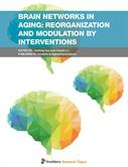Explore

Brain Networks in Aging: Reorganization and Modulation by Interventions
Junfeng Sun and Chunbo Li
2018
0 Ungluers have
Faved this Work
Login to Fave
Old adults undertake multiple reduced cognitive abilities in aging, which are accompanied with specific brain reorganization in forms of regional brain activity and brain tissues, inter-region connectivity, and topology of whole brain networks in both function and structure. The plasticity changes of brain activities in old adults are explained by the mechanisms of compensation and dedifferentiation. For example, older adults have been observed to have greater, usually bilateral, prefrontal activities during memory tasks compared to the typical unilateral prefrontal activities in younger adults, which was explained as a compensation for the reduced brain activities in visual processing cortices. Dedifferentiation is another mechanism to explain that old adults are with much less selective and less distinct activity in task-relevant brain regions compared with younger adults. A larger number of studies have examined the plasticity changes of brain from the perspective of regional brain activities. However, studies on only regional brain activities cannot fully elucidate the neural mechanisms of reduced cognitive abilities in aging, as multiple regions are integrated together to achieve advanced cognitive function in human brain. In recent years, brain connectivity/network, which targets how brain regions are integrated, have drawn increasing attention in neuroscience with the development of neuroimaging techniques and graph theoretical analysis. Connectivity quantifies functional association or neural fibers between two regions that may be spatially far separated, and graph theoretical analysis of brain network examines the complex interactions among multiple regions from the perspective of topology. Studies showed that compared to younger adults, older adults had altered strength of task-relevant functional connectivity between specific brain regions in cognitive tasks, and the alternation of connectivity are correlated to behavior performance. For example, older adults had weaker functional connectivity between the premotor cortex and a region in the left dorsolateral prefrontal cortex in a working memory task. Interventions like cognitive training and neuro-modulation (e.g., transcranial magnetic stimulation) have been shown to be promising in regaining or retaining the decreasing cognitive abilities in aging. However, only few neuroimaging studies have examined the influence of interventions to old adult’s brain activity, connectivity, and cognitive performance. This Research Topic calls for contributions on brain network of subjects in normal aging or with age-related diseases like mild cognitive impairment and Alzheimer’s disease. The studies are expected to be based on neuroimaging techniques including but not limited to functional magnetic resonance imaging, Electroencephalography, and diffusion tensor imaging, and contributions on the influence of interventions to brain networks in aging are highly encouraged. All these studies would enrich our understanding of neural mechanisms underlying aging, and offer new insights for developing possible interventions to retain cognitive abilities in aging subjects.
This book is included in DOAB.
Why read this book? Have your say.
You must be logged in to comment.
